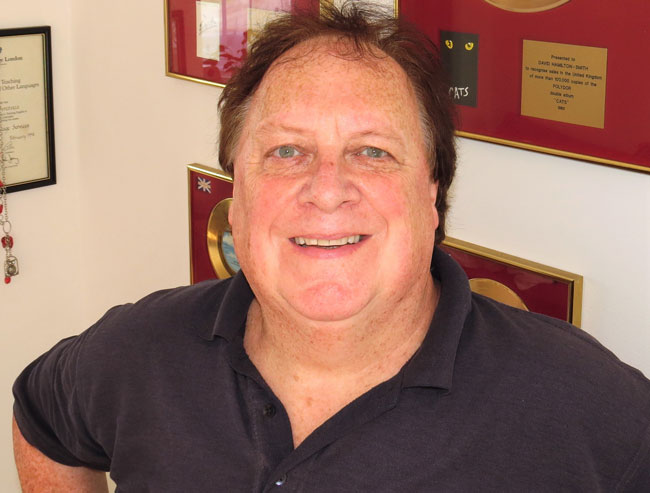Broadcast News
27/09/2016
Sound Dynamics In Broadcasting

I doubt if there is anyone amongst us who has not had to reach for their remote control while watching television – and I don't mean in order to avoid repeats, says sound engineer David Hamilton-Smith.
The problem we have all encountered is that of dramatically fluctuating sound levels within the programme. This is true of all genres to a greater or lesser extent, including documentaries, comedies, game shows, dramas, and the most frequent offender of all, feature films. Noticeable level jumps also often occur when we switch from one channel to another, not to mention the increase in level inexplicably allowed for commercial breaks.
Each one of us becomes a home sound engineer, continually having to press the Volume + and – buttons on our remotes as we desperately try to turn up the dialogue one moment then turn down the thundering effects and music the next. But why do we have to do all this button pushing?
As consumers we can be forgiven for expecting the material being pumped into our homes to be at one optimum level. Theoretically it should be entirely up to us to decide just how loud or quiet we want our personal playback to be, and, once set, we should be able to hear everything without having to tweak the level up and down. In practice we all know this is not the case. You would think that with the plethora of technical specifications issued by every broadcaster for all professional dubbing mixers to adhere to before submitting their finished masters there should be a fighting chance of getting a level playing field for broadcast audio. And you'd be right. Yet we continue to experience a roller-coaster ride of differing volumes.
So why is this? Let's take feature films as an example, especially action movies, the biggest source of volume pressing at home. The dynamic range of an action movie is considerable. These are mixed for large soundproofed cinemas where we sit, supposedly in silence, to view them. Thus we can hear the tiniest pin drop and the quietest, whispered dialogue, except when someone insists on unwrapping sweets, slurping over-sized drinks and munching on nachos and crisps! At home there is far more background noise for our television sound to fight through. So we can't hear that whispered dialogue over the daily cacophony of life without pushing up the volume.
In the cinema special effects and explosions will be the loudest elements simply because the sound engineers mixed them that way for impact. A recent study by audio engineers compared a film like the Matrix with a sitcom. They postulated that if the Matrix has a dynamic range (whispered dialogue to huge explosions) of say 25 units, a sitcom would only have a range of 6 units.
Despite the encouraging increase in sales of surround sound systems, the vast majority of people still only have the integral speakers in their television sets to listen to, or they might play the TV sound through their stereo hi-fi. In these cases they rely upon the television manufacturer to have implemented Dolby's recommendations for 'downsampling' those discreet channels from say 5.1 (left front, centre, right front, left surround, right surround and subwoofer) to 2.0. Some designers have not bothered to do this, and simply mash the channels into a stereo pair, thus exacerbating the dynamic sound level issues. Even if you are lucky enough to have a superb surround sound system you will still be, almost certainly, at the mercy of the too-loud-effects-too-quiet-dialogue problem unless you have turned one room of your mansion into a soundproofed home cinema. I have a good system in an ordinary living room. It sounds great – but I still find myself constantly having to adjust the sound volume during programmes.
So why don't the film companies remix their films for television? Well, frankly, economics. A few years ago I was involved in remixing some major feature films from their original stems for the broadcast market here and abroad. Our remit was to narrow the dynamic range to make the difference in levels between the dialogue and the rest of the sound far less noticeable when the surround channels were 'collapsed' to stereo. This made those films far more user-friendly in the home environment. Unsurprisingly the cost of doing this for every film would be prohibitive. The contract came to an end partly due to this but also because of the movement towards 'home cinema' systems, which the film companies thought would handle the original dynamics and therefore negate the need for remixing. Unfortunately our faded symbols on our home remotes prove that whatever technology we have right now does not solve the problem.
Broadcasters issue technical requirements for all 'deliverables'. A documentary may just have a stereo full mix and a stereo M&E (music and effects, with sync dialogue, but no voice-over). A film or drama, as well as the final mix in surround, would probably include the full mix in stereo, a mix minus (everything but the dialogues, so that other languages can be dubbed on) and various chosen 'separates' (e.g. stereo music, stereo effects, dialogue, foley, background atmospheres, full mix, mix minus, etc) on a physical digital medium like DA88, all to very specific levels.
As a dubbing mixer myself I can categorically state that every professional sound engineer I know is fastidiously diligent when it comes to making sure whatever they are mixing meets the broadcasters' specifications. So again, why the enormous disparity in broadcast sound levels? Admittedly specifications vary from channel to channel, but hardly to the point where there are such massive differences in programme levels.
In my opinion, the fault often lies, ironically, in the very technology that the broadcast channels use to control and safeguard their output: compressors and limiters. I perfectly understand the necessity of protecting transmitters by employing a 'brick wall' limiter of some description. In radio the Orban Optimod seems to be ubiquitous. Radio uses these processors to reduce the dynamic range of the audio. This is particularly important for AM broadcasting where interference during quiet passages can be obtrusive, but is far less necessary for FM and Digital. So why do they still use it on FM and Digital? The answer points to one of my personal bête noirs – LOUDNESS. Broadcasters perceived that by using devices that scrunched up the dynamic range their output sounded louder. Similar thinking has resulted in various forms of limiter/compressor being used on television broadcasts, but their detail is seldom found in tech specs I've seen.
I understand the logic: crush the dynamic range and alleviate the problem of too-loud-effects-too-quiet-dialogue; plus everything will sound LOUDER. Win win. Wrong! Especially if the gizmo being utilised has typical compressor settings: 'Attack', 'Release', 'Ratio' and 'Gain'. If underneath the 'brick wall' limiter (beyond which no sound can go) you have activated the compressor side of the chain, the level of the sound, and its quality, are directly affected by whatever arbitrary settings may have been selected in order to make everything sound louder.
Here is an example: Recently I decided to find a new box set to watch. I chose at random 'Magic City', a series about Miami Beach mobsters set in the 1950s. Within a few minutes I had to turn it off. The dialogue was hitting a compressor so hard that the background atmospheres and music almost disappeared; then, when they stopped talking and the 'Release' setting of the compressor kicked in, the backgrounds and music lurched forward like a cross between a tsunami's tidal wave and the thundering of a stampeding herd. Room sounds, sea noises, footsteps all went to maximum volume until they were slammed down again when someone spoke. I checked other episodes and found them all to have the same technical sound issue. There is no way this was ever mixed like that.
In conclusion I have to admit that there does not seem to be a simple solution. More information about a broadcaster's output tech might help – but then again they could change settings on someone's whim. More diligence at the broadcast end would certainly help. The best way would be an agreement between all broadcasters standardising compression, limiting and level at the output stage, but this would be highly unlikely to happen. It may well be that whatever the technology we have, we will still continue to be home sound engineers, clasping our remotes and 'mixing' our preferred listening volume.
The problem we have all encountered is that of dramatically fluctuating sound levels within the programme. This is true of all genres to a greater or lesser extent, including documentaries, comedies, game shows, dramas, and the most frequent offender of all, feature films. Noticeable level jumps also often occur when we switch from one channel to another, not to mention the increase in level inexplicably allowed for commercial breaks.
Each one of us becomes a home sound engineer, continually having to press the Volume + and – buttons on our remotes as we desperately try to turn up the dialogue one moment then turn down the thundering effects and music the next. But why do we have to do all this button pushing?
As consumers we can be forgiven for expecting the material being pumped into our homes to be at one optimum level. Theoretically it should be entirely up to us to decide just how loud or quiet we want our personal playback to be, and, once set, we should be able to hear everything without having to tweak the level up and down. In practice we all know this is not the case. You would think that with the plethora of technical specifications issued by every broadcaster for all professional dubbing mixers to adhere to before submitting their finished masters there should be a fighting chance of getting a level playing field for broadcast audio. And you'd be right. Yet we continue to experience a roller-coaster ride of differing volumes.
So why is this? Let's take feature films as an example, especially action movies, the biggest source of volume pressing at home. The dynamic range of an action movie is considerable. These are mixed for large soundproofed cinemas where we sit, supposedly in silence, to view them. Thus we can hear the tiniest pin drop and the quietest, whispered dialogue, except when someone insists on unwrapping sweets, slurping over-sized drinks and munching on nachos and crisps! At home there is far more background noise for our television sound to fight through. So we can't hear that whispered dialogue over the daily cacophony of life without pushing up the volume.
In the cinema special effects and explosions will be the loudest elements simply because the sound engineers mixed them that way for impact. A recent study by audio engineers compared a film like the Matrix with a sitcom. They postulated that if the Matrix has a dynamic range (whispered dialogue to huge explosions) of say 25 units, a sitcom would only have a range of 6 units.
Despite the encouraging increase in sales of surround sound systems, the vast majority of people still only have the integral speakers in their television sets to listen to, or they might play the TV sound through their stereo hi-fi. In these cases they rely upon the television manufacturer to have implemented Dolby's recommendations for 'downsampling' those discreet channels from say 5.1 (left front, centre, right front, left surround, right surround and subwoofer) to 2.0. Some designers have not bothered to do this, and simply mash the channels into a stereo pair, thus exacerbating the dynamic sound level issues. Even if you are lucky enough to have a superb surround sound system you will still be, almost certainly, at the mercy of the too-loud-effects-too-quiet-dialogue problem unless you have turned one room of your mansion into a soundproofed home cinema. I have a good system in an ordinary living room. It sounds great – but I still find myself constantly having to adjust the sound volume during programmes.
So why don't the film companies remix their films for television? Well, frankly, economics. A few years ago I was involved in remixing some major feature films from their original stems for the broadcast market here and abroad. Our remit was to narrow the dynamic range to make the difference in levels between the dialogue and the rest of the sound far less noticeable when the surround channels were 'collapsed' to stereo. This made those films far more user-friendly in the home environment. Unsurprisingly the cost of doing this for every film would be prohibitive. The contract came to an end partly due to this but also because of the movement towards 'home cinema' systems, which the film companies thought would handle the original dynamics and therefore negate the need for remixing. Unfortunately our faded symbols on our home remotes prove that whatever technology we have right now does not solve the problem.
Broadcasters issue technical requirements for all 'deliverables'. A documentary may just have a stereo full mix and a stereo M&E (music and effects, with sync dialogue, but no voice-over). A film or drama, as well as the final mix in surround, would probably include the full mix in stereo, a mix minus (everything but the dialogues, so that other languages can be dubbed on) and various chosen 'separates' (e.g. stereo music, stereo effects, dialogue, foley, background atmospheres, full mix, mix minus, etc) on a physical digital medium like DA88, all to very specific levels.
As a dubbing mixer myself I can categorically state that every professional sound engineer I know is fastidiously diligent when it comes to making sure whatever they are mixing meets the broadcasters' specifications. So again, why the enormous disparity in broadcast sound levels? Admittedly specifications vary from channel to channel, but hardly to the point where there are such massive differences in programme levels.
In my opinion, the fault often lies, ironically, in the very technology that the broadcast channels use to control and safeguard their output: compressors and limiters. I perfectly understand the necessity of protecting transmitters by employing a 'brick wall' limiter of some description. In radio the Orban Optimod seems to be ubiquitous. Radio uses these processors to reduce the dynamic range of the audio. This is particularly important for AM broadcasting where interference during quiet passages can be obtrusive, but is far less necessary for FM and Digital. So why do they still use it on FM and Digital? The answer points to one of my personal bête noirs – LOUDNESS. Broadcasters perceived that by using devices that scrunched up the dynamic range their output sounded louder. Similar thinking has resulted in various forms of limiter/compressor being used on television broadcasts, but their detail is seldom found in tech specs I've seen.
I understand the logic: crush the dynamic range and alleviate the problem of too-loud-effects-too-quiet-dialogue; plus everything will sound LOUDER. Win win. Wrong! Especially if the gizmo being utilised has typical compressor settings: 'Attack', 'Release', 'Ratio' and 'Gain'. If underneath the 'brick wall' limiter (beyond which no sound can go) you have activated the compressor side of the chain, the level of the sound, and its quality, are directly affected by whatever arbitrary settings may have been selected in order to make everything sound louder.
Here is an example: Recently I decided to find a new box set to watch. I chose at random 'Magic City', a series about Miami Beach mobsters set in the 1950s. Within a few minutes I had to turn it off. The dialogue was hitting a compressor so hard that the background atmospheres and music almost disappeared; then, when they stopped talking and the 'Release' setting of the compressor kicked in, the backgrounds and music lurched forward like a cross between a tsunami's tidal wave and the thundering of a stampeding herd. Room sounds, sea noises, footsteps all went to maximum volume until they were slammed down again when someone spoke. I checked other episodes and found them all to have the same technical sound issue. There is no way this was ever mixed like that.
In conclusion I have to admit that there does not seem to be a simple solution. More information about a broadcaster's output tech might help – but then again they could change settings on someone's whim. More diligence at the broadcast end would certainly help. The best way would be an agreement between all broadcasters standardising compression, limiting and level at the output stage, but this would be highly unlikely to happen. It may well be that whatever the technology we have, we will still continue to be home sound engineers, clasping our remotes and 'mixing' our preferred listening volume.
More Broadcast Audio Stories
08/03/2023
DHD.audio Completes Studio Upgrade For Radio Kol Rega
DHD.audio has completed a studio upgrade for regional broadcaster Radio Kol Rega at the network's headquarters in Lower Galilee. The project was super
DHD.audio Completes Studio Upgrade For Radio Kol Rega
DHD.audio has completed a studio upgrade for regional broadcaster Radio Kol Rega at the network's headquarters in Lower Galilee. The project was super
30/01/2020
SSL Releases V2.3 System T Broadcast Production Platform
Solid State Logic (SSL) has released the latest V2.3 System T broadcast production platform, adding significant benefits to the entire range of System
SSL Releases V2.3 System T Broadcast Production Platform
Solid State Logic (SSL) has released the latest V2.3 System T broadcast production platform, adding significant benefits to the entire range of System
25/03/2019
DPA Microphones Scoops Prestigious Award
DPA Microphones' d:fine™ CORE 6066 Subminiature Headset Microphone has been awarded a prestigious Red Dot Award in the Product Design 2019 category. P
DPA Microphones Scoops Prestigious Award
DPA Microphones' d:fine™ CORE 6066 Subminiature Headset Microphone has been awarded a prestigious Red Dot Award in the Product Design 2019 category. P
11/04/2018
BFV's Big Interview: JoeCo
Based near Cambridge, JoeCo has worked in audio design for over 10 years by providing solutions for music and audio people worldwide. This month, Broa
BFV's Big Interview: JoeCo
Based near Cambridge, JoeCo has worked in audio design for over 10 years by providing solutions for music and audio people worldwide. This month, Broa
10/04/2018
Riedel Introduces 1200 Series Smartpanel At NAB
Riedel Communications has debuted the new 1200 series Smartpanel at the 2018 NAB Show. The RSP-1232HL features multiple full-color multitouch displays
Riedel Introduces 1200 Series Smartpanel At NAB
Riedel Communications has debuted the new 1200 series Smartpanel at the 2018 NAB Show. The RSP-1232HL features multiple full-color multitouch displays
09/03/2018
Audio, No Longer The Silent Partner
With more mixed SDI / IP and 'all IP' installations being designed and implemented it raises a few additional challenges for audio engineering. SMPTE
Audio, No Longer The Silent Partner
With more mixed SDI / IP and 'all IP' installations being designed and implemented it raises a few additional challenges for audio engineering. SMPTE
08/03/2018
Vortex Introduce New ACCESS-NX
ACCESS-NX is the latest incarnation of the industry-standard ACCESS-IP from Comrex and provides a step-change in stability and resilience in IP audio
Vortex Introduce New ACCESS-NX
ACCESS-NX is the latest incarnation of the industry-standard ACCESS-IP from Comrex and provides a step-change in stability and resilience in IP audio
14/02/2018
DPA Microphones - First Choice For Range Of Television Shows
The cutting edge innovation of new clips for DPA's popular d:screet™ 4060 Omnidirectional Miniature Microphones has delivered such a significant impro
DPA Microphones - First Choice For Range Of Television Shows
The cutting edge innovation of new clips for DPA's popular d:screet™ 4060 Omnidirectional Miniature Microphones has delivered such a significant impro
01/12/2017
Further Investment By DPA Microphones
Following its recent acquisition of Sound Network, DPA Microphones has announced that it is also set to strengthen its presence in Germany – by establ
Further Investment By DPA Microphones
Following its recent acquisition of Sound Network, DPA Microphones has announced that it is also set to strengthen its presence in Germany – by establ
30/11/2017
DPA Microphones Acquires Sound Network
DPA Microphones has announced the acquisition of UK pro audio distributor Sound Network. The two firms have worked together for more than 20 years and
DPA Microphones Acquires Sound Network
DPA Microphones has announced the acquisition of UK pro audio distributor Sound Network. The two firms have worked together for more than 20 years and















